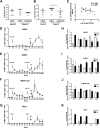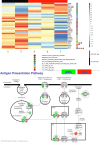Antibodies to gp120 and PD-1 expression on virus-specific CD8+ T cells in protection from simian AIDS
- PMID: 23325679
- PMCID: PMC3592123
- DOI: 10.1128/JVI.02686-12
Antibodies to gp120 and PD-1 expression on virus-specific CD8+ T cells in protection from simian AIDS
Abstract
We compared the relative efficacies against simian immunodeficiency virus (SIV) challenge of three vaccine regimens that elicited similar frequencies of SIV-specific CD4(+) and CD8(+) T-cell responses but differed in the level of antibody responses to the gp120 envelope protein. All macaques were primed with DNA plasmids expressing SIV gag, pol, env, and Retanef genes and were boosted with recombinant modified vaccinia Ankara virus (MVA) expressing the same genes, either once (1 × MVA) or twice (2 × MVA), or were boosted once with MVA followed by a single boost with replication-competent adenovirus (Ad) type 5 host range mutant (Ad5 h) expressing SIV gag and nef genes but not Retanef or env (1 × MVA/Ad5). While two of the vaccine regimens (1 × MVA and 1 × MVA/Ad5) protected from high levels of SIV replication only during the acute phase of infection, the 2 × MVA regimen, with the highest anti-SIV gp120 titers, protected during the acute phase and transiently during the chronic phase of infection. Mamu-A*01 macaques of this third group exhibited persistent Gag CD8(+)CM9(+) effector memory T cells with low expression of surface Programmed death-1 (PD-1) receptor and high levels of expression of genes associated with major histocompatibility complex class I (MHC-I) and MHC-II antigen. The fact that control of SIV replication was associated with both high titers of antibodies to the SIV envelope protein and durable effector SIV-specific CD8(+) T cells suggests the hypothesis that the presence of antibodies at the time of challenge may increase innate immune recruiting activity by enhancing antigen uptake and may result in improvement of the quality and potency of secondary SIV-specific CD8(+) T-cell responses.
Figures




Similar articles
-
Virus-Like Particles Displaying Trimeric Simian Immunodeficiency Virus (SIV) Envelope gp160 Enhance the Breadth of DNA/Modified Vaccinia Virus Ankara SIV Vaccine-Induced Antibody Responses in Rhesus Macaques.J Virol. 2016 Sep 12;90(19):8842-54. doi: 10.1128/JVI.01163-16. Print 2016 Oct 1. J Virol. 2016. PMID: 27466414 Free PMC article.
-
Comparative efficacy of recombinant modified vaccinia virus Ankara expressing simian immunodeficiency virus (SIV) Gag-Pol and/or Env in macaques challenged with pathogenic SIV.J Virol. 2000 Mar;74(6):2740-51. doi: 10.1128/jvi.74.6.2740-2751.2000. J Virol. 2000. PMID: 10684290 Free PMC article.
-
CD40L-adjuvanted DNA/modified vaccinia virus Ankara simian immunodeficiency virus SIV239 vaccine enhances SIV-specific humoral and cellular immunity and improves protection against a heterologous SIVE660 mucosal challenge.J Virol. 2014 Sep 1;88(17):9579-89. doi: 10.1128/JVI.00975-14. Epub 2014 Jun 11. J Virol. 2014. PMID: 24920805 Free PMC article.
-
Relevance of studying T cell responses in SIV-infected rhesus macaques.Trends Microbiol. 2008 Dec;16(12):605-11. doi: 10.1016/j.tim.2008.08.010. Epub 2008 Oct 27. Trends Microbiol. 2008. PMID: 18964016 Free PMC article. Review.
-
HIV vaccine research and discovery in the nonhuman primates model: a unified theory in acquisition prevention and control of SIV infection.Curr Opin HIV AIDS. 2013 Jul;8(4):288-94. doi: 10.1097/COH.0b013e328361cfe8. Curr Opin HIV AIDS. 2013. PMID: 23666390 Free PMC article. Review.
Cited by
-
Using nonhuman primates to model HIV transmission.Curr Opin HIV AIDS. 2013 Jul;8(4):280-7. doi: 10.1097/COH.0b013e328361cfff. Curr Opin HIV AIDS. 2013. PMID: 23666391 Free PMC article. Review.
-
Recombinant lentogenic Newcastle disease virus expressing Ebola virus GP infects cells independently of exogenous trypsin and uses macropinocytosis as the major pathway for cell entry.Virol J. 2013 Nov 9;10:331. doi: 10.1186/1743-422X-10-331. Virol J. 2013. PMID: 24209904 Free PMC article.
References
-
- Buchbinder SP, Mehrotra DV, Duerr A, Fitzgerald DW, Mogg R, Li D, Gilbert PB, Lama JR, Marmor M, Del RC, McElrath MJ, Casimiro DR, Gottesdiener KM, Chodakewitz JA, Corey L, Robertson MN. 2008. Efficacy assessment of a cell-mediated immunity HIV-1 vaccine (the Step Study): a double-blind, randomised, placebo-controlled, test-of-concept trial. Lancet 372:1881–1893 - PMC - PubMed
-
- Edupuganti S, Weber D, Poole C. 2004. Cytotoxic T-lymphocyte responses to canarypox vector-based HIV vaccines in HIV-seronegative individuals: a meta-analysis of published studies. HIV Clin. Trials 5:259–268 - PubMed
-
- Flynn NM, Forthal DN, Harro CD, Judson FN, Mayer KH, Para MF. 2005. Placebo-controlled phase 3 trial of a recombinant glycoprotein 120 vaccine to prevent HIV-1 infection. J. Infect. Dis. 191:654–665 - PubMed
-
- Rerks-Ngarm S, Pitisuttithum P, Nitayaphan S, Kaewkungwal J, Chiu J, Paris R, Premsri N, Namwat C, SMde Adams E, Benenson M, Gurunathan S, Tartaglia J, McNeil JG, Francis DP, Stablein D, Birx DL, Chunsuttiwat S, Khamboonruang C, Thongcharoen P, Robb ML, Michael NL, Kunasol P, Kim JH. 2009. Vaccination with ALVAC and AIDSVAX to prevent HIV-1 infection in Thailand. N. Engl. J. Med. 361:2209–2220 - PubMed
-
- Franchini G, Gurunathan S, Baglyos L, Plotkin S, Tartaglia J. 2004. Poxvirus-based vaccine candidates for HIV: two decades of experience with special emphasis on canarypox vectors. Expert Rev. Vaccines 3(Suppl 1):S75–S88 - PubMed
Publication types
MeSH terms
Substances
Grants and funding
LinkOut - more resources
Full Text Sources
Other Literature Sources
Research Materials

